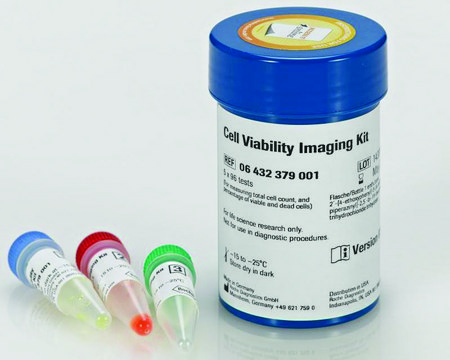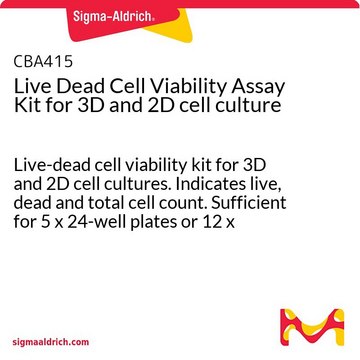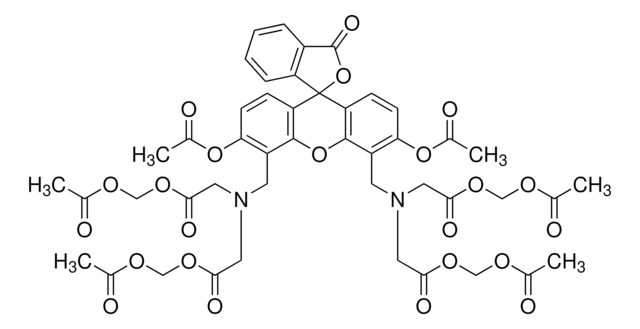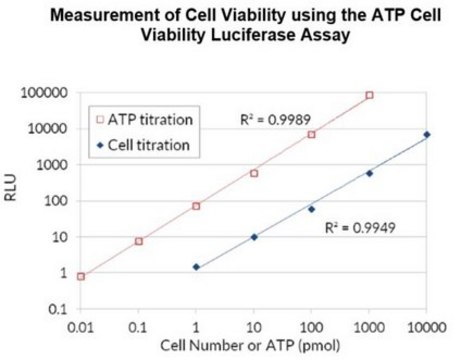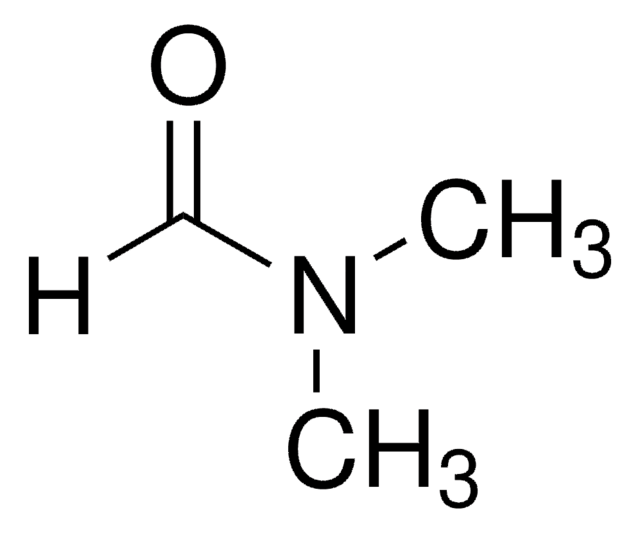推荐产品
检测方法
colorimetric
一般描述
NAD+/NADH and NADP+/NADPH are important biological cofactors for oxidoreductase enzymes that are fundamental for various biological processes, such as energy metabolism, mitochondrial function, oxidative stress, immunological functions and cell death. Hence the oxidoreductase enzymes are used as indicators of metabolic activity of cells.
Traditional tetrazolium salts, such as MTT, react with NAD(P)H-dependent cellular oxidoreductase enzymes to produce an insoluble formazan, which requires solubilization and have lower sensitivity. Moreover, they cannot reliably detect cell viability in low density cultures, such as primary cell cultures.
EZMTT viability assay solution is based on a novel monosulfonated tetrazolium salt, 2-(3-(2-methoxy-4-nitrophenyl)-2-(4-nitrophenyl)-2H-tetrazol-3-ium-5-yl) benzenesulfonate sodium salt (EZMTT). The EZMTT reagents provided high quality and reproducible detection for oxidoreductase enzymes, indicators of cellular metabolic activity. Upon reacting with metabolic enzymes, EZMTT is converted to a yellowish formazan that does not require solubilization step and can be measured by absorbance at 450 nm. EZMTT assay can be used to measure cell viability and cytotoxicity (loss of viable cells), or cytostatic activity (shift from proliferation to quiescence) of potential medicinal or toxic agents.
<bold>Features and Benefits of EZMTT:</bold>
• EZMTT solution can be premixed with any media and buffer and added directly to the cells.
• EZMTT is very sensitive and can be used to detect metabolic activity of low-density or suspension cell cultures.
• Reduction of EZMTT produces a water-soluble yellow formazan dye, which does not require solubilization step
• Can be used for end-point viability assay of mammalian as well as bacterial cells
• Much less reactive with other antioxidants such as beta-Mercaptoethanol (BME)
• More sensitive than the traditional MTT assays
Assay Protocol for titration:
1. Detach cells and seed different cell number (0, 1000, 2000, 5000, 10000) in each well of 96-well plate with 10% FBS DMEM in triplicates.
2. Incubate at 37?C, 5% CO? for 3-4 hours or overnight.
3. Then change the culture medium with 100 μl of 10% FBS DMEM (optional).
4. Thaw and Mix EZMTT cell viability assay solution with culture media (10X dilute).
5. Add 10X EZMTT solution to each well of the plate (final 1Xdilute).
6. Incubate the plate for 1-4 hours in the incubator.
Measure the absorbance at 450 nm using a microplate reader.
Assay Protocol for toxicity studies:
1. Detach cells and seed cell number (1000) in well (1-11 columns) of 96-well plate with 10% FBS DMEM in triplicates.
2. Incubate at 37?C, 5% CO? for 3-4 hours. Then add compounds (e.g. final 0-30 μg/ml, 2 fold dilutions) and incubated for 3-5 days.
3. Then change the culture medium with 100 μl of 10% FBS DMEM. (optional)
4. Thaw and Mix EZMTT TM cell viability assay solution with culture media (10X dilute).
5. Add 10X EZMTT TM solution to each well of the plate (final 1Xdilute).
6. Incubate the plate for 1-4 hours in the incubator.
Measure the absorbance at 450 nm using a microplate reader.
Traditional tetrazolium salts, such as MTT, react with NAD(P)H-dependent cellular oxidoreductase enzymes to produce an insoluble formazan, which requires solubilization and have lower sensitivity. Moreover, they cannot reliably detect cell viability in low density cultures, such as primary cell cultures.
EZMTT viability assay solution is based on a novel monosulfonated tetrazolium salt, 2-(3-(2-methoxy-4-nitrophenyl)-2-(4-nitrophenyl)-2H-tetrazol-3-ium-5-yl) benzenesulfonate sodium salt (EZMTT). The EZMTT reagents provided high quality and reproducible detection for oxidoreductase enzymes, indicators of cellular metabolic activity. Upon reacting with metabolic enzymes, EZMTT is converted to a yellowish formazan that does not require solubilization step and can be measured by absorbance at 450 nm. EZMTT assay can be used to measure cell viability and cytotoxicity (loss of viable cells), or cytostatic activity (shift from proliferation to quiescence) of potential medicinal or toxic agents.
<bold>Features and Benefits of EZMTT:</bold>
• EZMTT solution can be premixed with any media and buffer and added directly to the cells.
• EZMTT is very sensitive and can be used to detect metabolic activity of low-density or suspension cell cultures.
• Reduction of EZMTT produces a water-soluble yellow formazan dye, which does not require solubilization step
• Can be used for end-point viability assay of mammalian as well as bacterial cells
• Much less reactive with other antioxidants such as beta-Mercaptoethanol (BME)
• More sensitive than the traditional MTT assays
Assay Protocol for titration:
1. Detach cells and seed different cell number (0, 1000, 2000, 5000, 10000) in each well of 96-well plate with 10% FBS DMEM in triplicates.
2. Incubate at 37?C, 5% CO? for 3-4 hours or overnight.
3. Then change the culture medium with 100 μl of 10% FBS DMEM (optional).
4. Thaw and Mix EZMTT cell viability assay solution with culture media (10X dilute).
5. Add 10X EZMTT solution to each well of the plate (final 1Xdilute).
6. Incubate the plate for 1-4 hours in the incubator.
Measure the absorbance at 450 nm using a microplate reader.
Assay Protocol for toxicity studies:
1. Detach cells and seed cell number (1000) in well (1-11 columns) of 96-well plate with 10% FBS DMEM in triplicates.
2. Incubate at 37?C, 5% CO? for 3-4 hours. Then add compounds (e.g. final 0-30 μg/ml, 2 fold dilutions) and incubated for 3-5 days.
3. Then change the culture medium with 100 μl of 10% FBS DMEM. (optional)
4. Thaw and Mix EZMTT TM cell viability assay solution with culture media (10X dilute).
5. Add 10X EZMTT TM solution to each well of the plate (final 1Xdilute).
6. Incubate the plate for 1-4 hours in the incubator.
Measure the absorbance at 450 nm using a microplate reader.
储存及稳定性
Store EZMTT celhigh senstivity cell viability assay at -20°C and protect from light.
免责声明
Unless otherwise stated in our catalog or other company documentation accompanying the product(s), our products are intended for research use only and are not to be used for any other purpose, which includes but is not limited to, unauthorized commercial uses, in vitro diagnostic uses, ex vivo or in vivo therapeutic uses or any type of consumption or application to humans or animals.
储存分类代码
10 - Combustible liquids
WGK
WGK 2
闪点(°F)
188.6 °F - (refers to pure substance)
闪点(°C)
87 °C - (refers to pure substance)
法规信息
新产品
实验方案
Learn how to perform cell migration assays in vitro using Millicell® hanging cell culture inserts and the suspension T-cell lines Jurkat and primary CD4+ cells. Monitor migration by flow cytometry and EZ-MTT assays.
我们的科学家团队拥有各种研究领域经验,包括生命科学、材料科学、化学合成、色谱、分析及许多其他领域.
联系技术服务部门